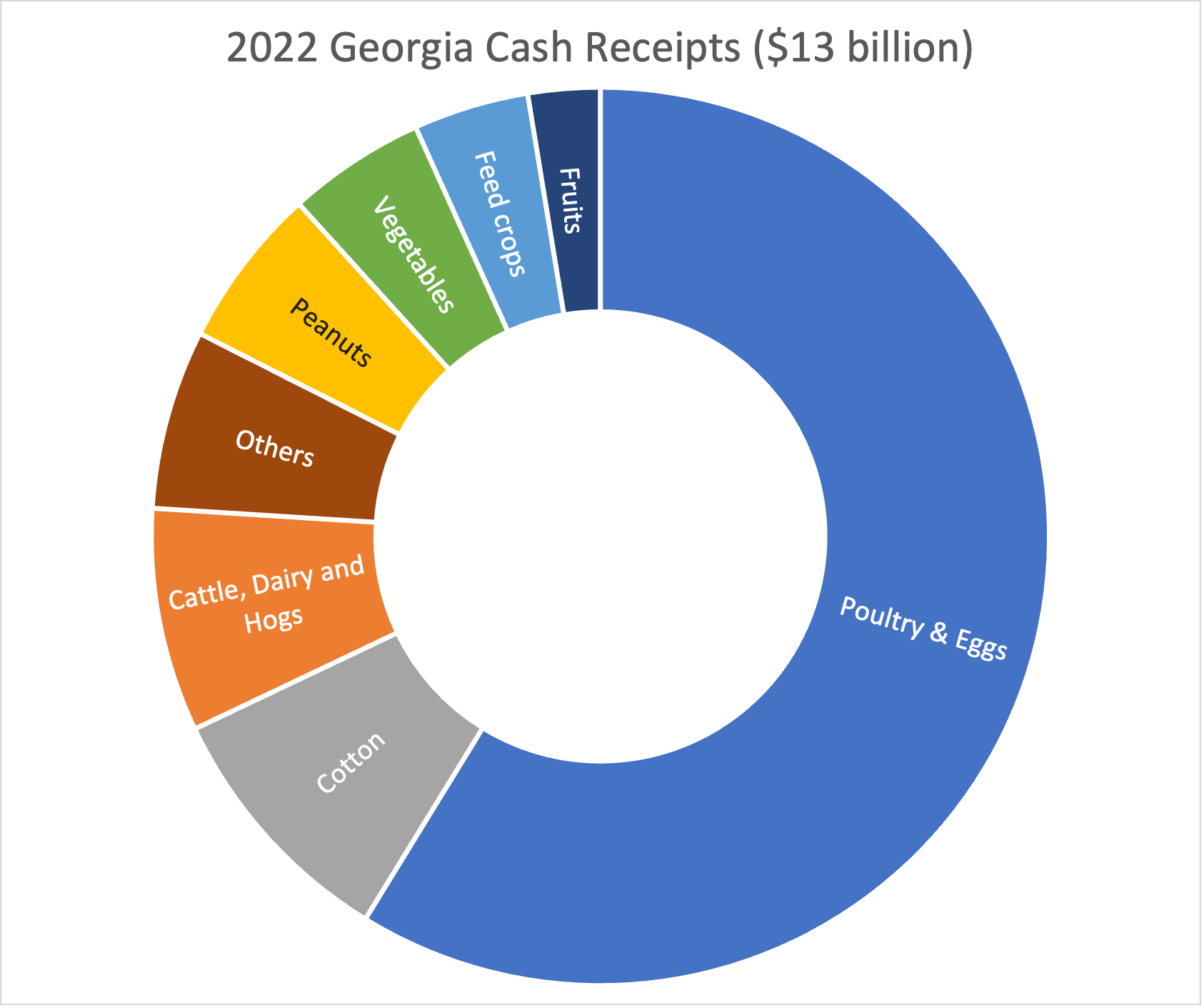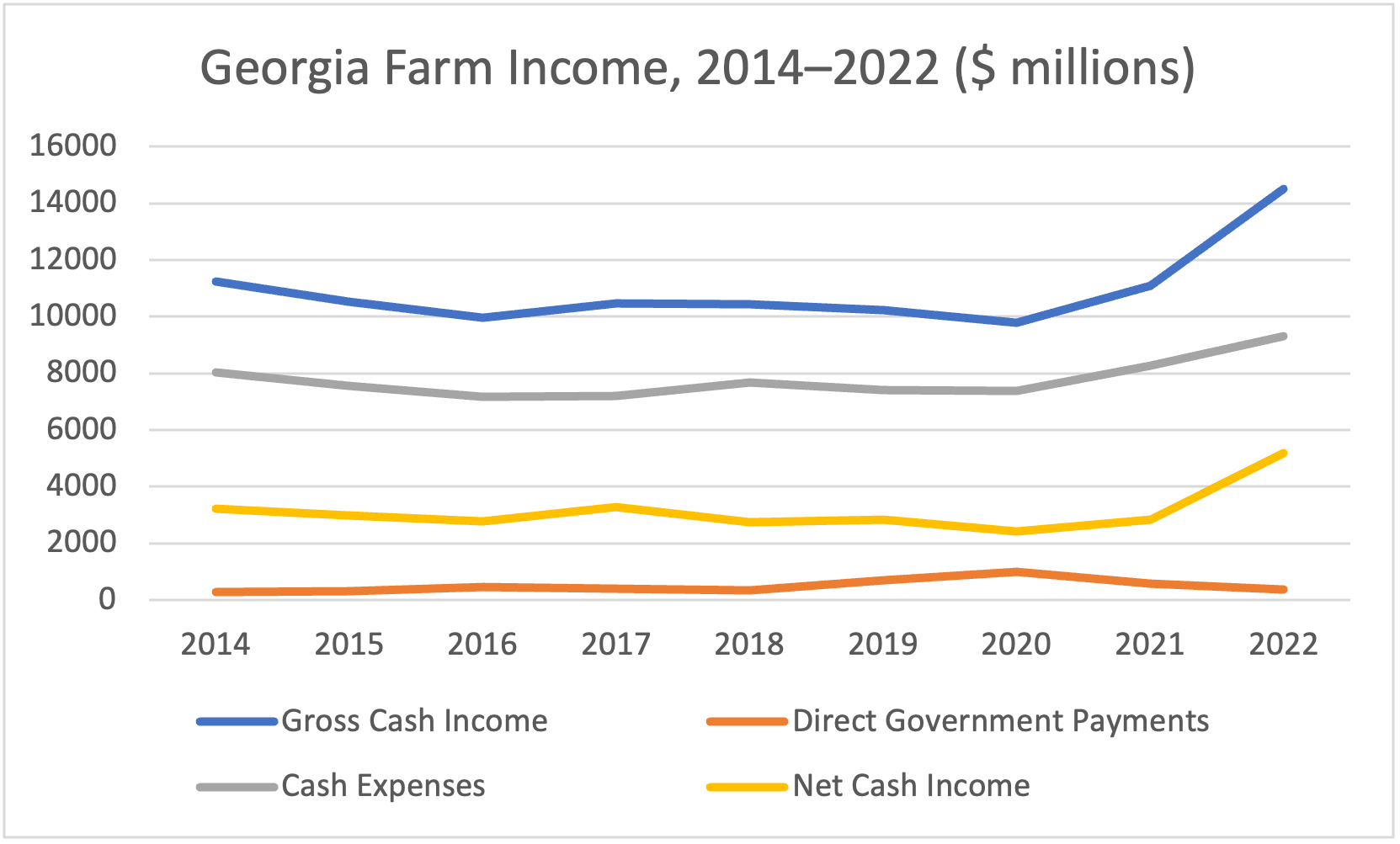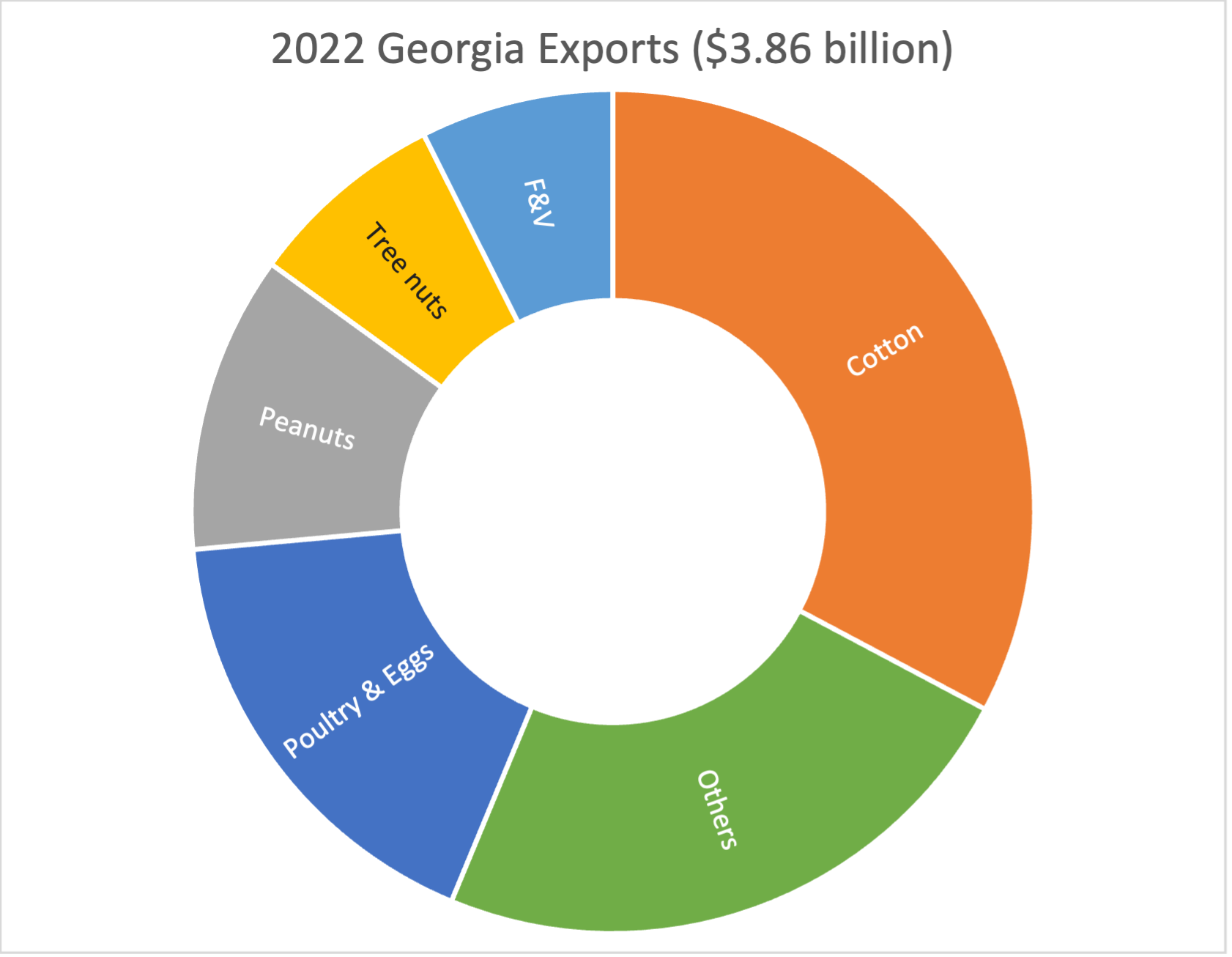Main Takeaways
- In 2024, the broader U.S. economy likely will experience a slowdown along with lower price inflation. Food and commodity prices also are expected to return to pre-pandemic levels.
- The most recent USDA farm income forecast, which indicates falling output prices, signals lower revenues across the board for crops and livestock. Coupled with slightly increasing costs, the nation’s farm income is expected to decline by 17% between 2022 and 2023.
- Georgia’s 2023 net farm income is likely to return to the 10-year average of about $3 billion.
- Potential upsides for Georgia are the possibility of higher demand for poultry, cotton, and peanuts from domestic and overseas markets.
- Risks to this forecast are higher input costs, geopolitical risks, cheaper imports of some commodities, and a global economic slowdown.
The consensus around the 2024 U.S. economic outlook suggests a slowdown in GDP growth and price inflation, accompanied by below-trend investment growth and a modest increase in the unemployment rate (Kliesen, 2023; UGA Selig Center for Economic Growth, 2023).
Government expenditures and net exports also are expected to witness lower growth because of concerns over federal debt and the strong U.S. dollar, respectively. Risks to economic growth and stability include the uncertain effects of inflation-targeted (2%) monetary policies; numerous geopolitical risks encompassing major economies of the world in Europe, China, Middle East, and others; and unexpected consequences of higher borrowing costs—defaults and delinquencies—especially in commercial real estate.
U.S. Agricultural Economy
The annual U.S. agricultural outlook from the U.S. Department of Agriculture (2023; early-release tables from USDA Agricultural Projections to 2033) indicates:
- Production is projected to grow among five of the eight major crops, including upland cotton, soybeans, wheat, corn, and rice during the projection period (2024–2033). Declines are expected for oats, barley, and sorghum. Despite reduced or flat acreage for most crops during the projections, yield growth pulls production either higher or limits the rate of production decline.
- Prices of all the crops remain steady or decline before stabilizing early in the projection period. This follows the record or near-record price environment during 2021 and 2022. Prices were very elevated because of strong demand, and there were production problems for many crops in 2021 and/or 2022.
- Net returns (revenues minus variable costs) per acre are significantly lower during the projection period for all crops after record levels for most of these crops were realized in the high-priced environment of 2021 or 2022. This is because prices initially decline and then stabilize. Changes in net returns are mixed, with barley, corn, and oats rising over the projection period, while the other crops experience moderate declines.
- U.S. crop exports are expected to remain steady or increase to various degrees over the next decade. The exception is soybean meal, which is projected to show an aggregate decline of 2.5%, but from elevated levels. Exports of corn, soybeans, wheat, rice, and upland cotton are expected to rise steadily over the projection period, but none reach record volumes.
Separately, USDA also forecasts that farm sector income is expected to fall in the near-term, after reaching record highs in 2022 (USDA Economic Research Service, 2023). Net farm income, a broad measure of profits, reached $182.8 billion in calendar year 2022, increasing $42.4 billion (30.2%) from 2021 in nominal dollars. However, in 2023, net farm income is forecast to decrease by $31.8 billion (17.4%) from 2022 to $151.1 billion. Key changes between 2022 and 2023 include:
- falling cash receipts for both crops and livestock (about a 5% decline), primarily from falling prices,
- increasing total production expenses, especially interest and livestock/poultry expenses (about 3.5%), and
- declining government payments (22.3%).
Georgia Agricultural Economy
Agriculture, a driving force for local economies across Georgia, has long shaped the state’s history. It has a $73.2 billion economic footprint from the production, processing, and wholesale segments of the food and fiber industries. Moreover, agriculture supports about 340,000 jobs in the state (Kane, 2023).
USDA reports of cash receipts show Georgia agriculture’s reliance on a few commodities, a trend in place for decades. Poultry and eggs, cotton, and peanuts account for 74% of Georgia’s cash receipts in 2022 (Figure 1). Among states, Georgia ranks 16th in total cash receipts. In addition to cash receipts, USDA provides information on direct government payments, net cash expenses, and net cash income by state. Georgia’s net cash income is $5.2 billion in 2022, a $2 billion increase from that of 2014. Georgia ranks 13th among U.S. states in net cash income. The historical trend shows a constant gap between income and expenses, which widened during the COVID-19 pandemic. Finally, according to USDA, Georgia ranks as the 18th largest exporter with exports of $3.86 billion. Major export commodities are cotton, poultry and eggs, peanuts, fruits and vegetables, and tree nuts.

2024 Economic Outlook for Georgia’s Agriculture
As noted earlier, the broader U.S. economy will likely experience a slowdown along with lower price inflation. Food and commodity prices are also expected to moderate to pre-pandemic levels. Although USDA does not project farm economy outlook by state, there is a high correlation between Georgia’s and national agriculture in terms of prices of outputs as well as inputs. Judging by the most recent USDA farm income forecast, falling output prices signal lower revenues across the board for crops and livestock. Coupled with stabilizing or slightly increasing costs—especially interest expenses and higher cost of feeder cattle/broiler chicks—Georgia’s net farm income is likely to fall to the historic trend of about $3 billion (Figure 2).

Potential upsides to this outlook for Georgia are the possibility of higher demand for (a) poultry products both from population and income growth overseas, and because of the constrained supplies of other meats (e.g., beef), and (b) cotton and peanuts from overseas markets (Figure 3).

Risks to this forecast are higher fertilizer, chemical, and labor costs (energy-price shock), geopolitical risks dampening exports, and a global economic slowdown. The fruits and vegetables industries face an additional challenge from cheaper imports from Mexico and South American countries produced during Georgia’s growing seasons.
References
Kane, S. (2023, January 27). 2023 Ag Snapshots (Publication No. AP 129-1). University of Georgia Cooperative Extension. https://extension.uga.edu/publications/detail.html?number=AP129-1
Kliesen, K. (2023, November 28). Slower GDP growth and falling inflation in U.S. economic outlook for 2024. Federal Reserve Bank of St. Louis. https://www.stlouisfed.org/publications/regional-economist/2023/nov/slower-gdp-growth-falling-inflation-us-economic-outlook-2024
UGA Selig Center for Economic Growth. (2023, December 11). Georgia economic outlook [lecture/event]. Atlanta, GA. https://www.terry.uga.edu/events/eo/
U.S. Department of Agriculture (USDA). (2023, November 7). Baseline projections. https://www.usda.gov/oce/commodity-markets/baseline
USDA Economic Research Service. (2023, November 30). Farm sector income & finances: Farm sector income forecast. https://www.ers.usda.gov/topics/farm-economy/farm-sector-income-finances/farm-sector-income-forecast/
Status and Revision History
In Review on Jan 19, 2024
Published on Jan 23, 2024


























































